I'm making an Add-in for PowerPoint 2013. My goal is to convert all equations that I find on slides to normal text, to change the font of those equations.
Because it won't let me change font while they are equations. I managed to find the equations, by iterating through text ranges and finding font name, they use "Cambria Math". So my question is how can programmatically change equations to normal text, Like the button in equation tools does? And it seems for some reason they removed "record macro" from PowerPoint, so I couldn't get help from that.
I tried recording macro in word and doing the same thing, and i got: Selection.OMaths(1).ConvertToMathText, but it doesn't seem to be OMaths in PowerPoint.
Dim Application As PowerPoint.Application = New PowerPoint.Application
Dim Presentation As PowerPoint.Presentation = Application.ActivePresentation
Dim Windows As PowerPoint.DocumentWindows = Application.Windows
For Each Slide As PowerPoint.Slide In Presentation.Slides
For Each Shape As PowerPoint.Shape In Slide.Shapes
For Each Paragraph As PowerPoint.TextRange In Shape.TextFrame.TextRange
For Each Line As PowerPoint.TextRange In Paragraph.Lines
If Line.Font.Name = "Cambria Math" Then
With Line.Font
.Name = "Calibri"
.Bold = True
End With
ElseIf Line.Font.Name = "Calibri" Then
With Line.Font
.Name = "Palatino"
End With
End If
Next Line
Next Paragraph
Next Shape
Next Slide
End Sub
Other text here is changed normally, but equations the ones with "Math Cambria" font, are unchanged.
I also tried to get selection, then something with OMaths, like in Word Vsto, but, it seems OMaths is not part of the PowerPoint. This next code is actually supposed to change it to equation, but i guess if it worked, could have find a way to reverse it.
For Each Window As PowerPoint.DocumentWindow In Windows
Selection.OMaths(1).ConvertToMathText
Next Window
